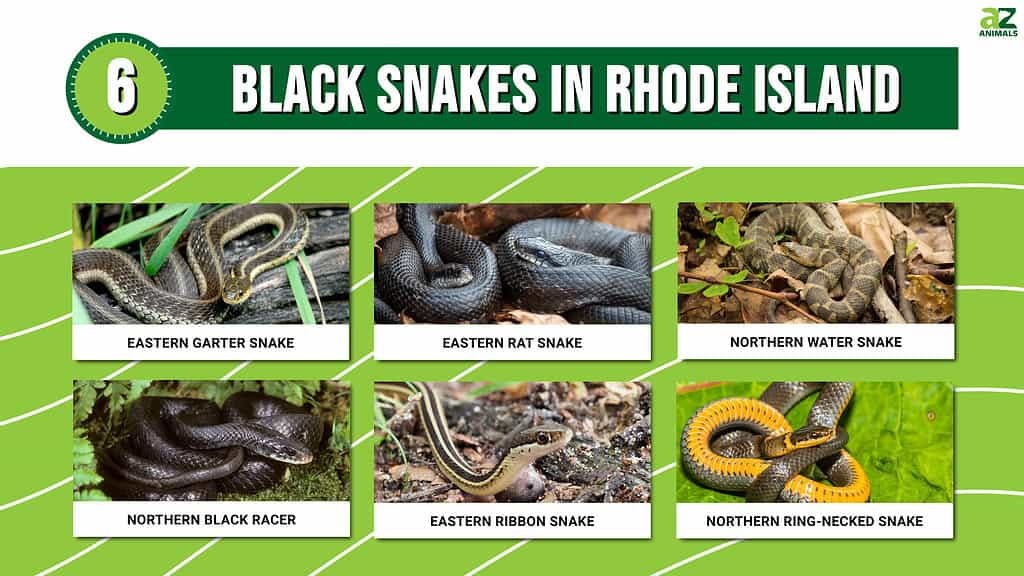
Rhode Island is a small state in the northeastern region of the United States. It is located on the coast and is nicknamed the Ocean State because of its vast number of beaches. The state itself is largely flat with its highest point being only 811 feet above sea level.
However, the state is still home to some fascinating animals. There are 12 snakes in Rhode Island and it is a good state to visit as none of them are venomous. Timber rattlesnakes once lived in Rhode Island but they disappeared from the state approximately 50 years ago.
However, if you’re out exploring then it’s a good idea to know which snakes you might come across. So, let’s discover the black snakes in Rhode Island!
1. Eastern Garter Snake (Thamnophis sirtalis sirtalis)
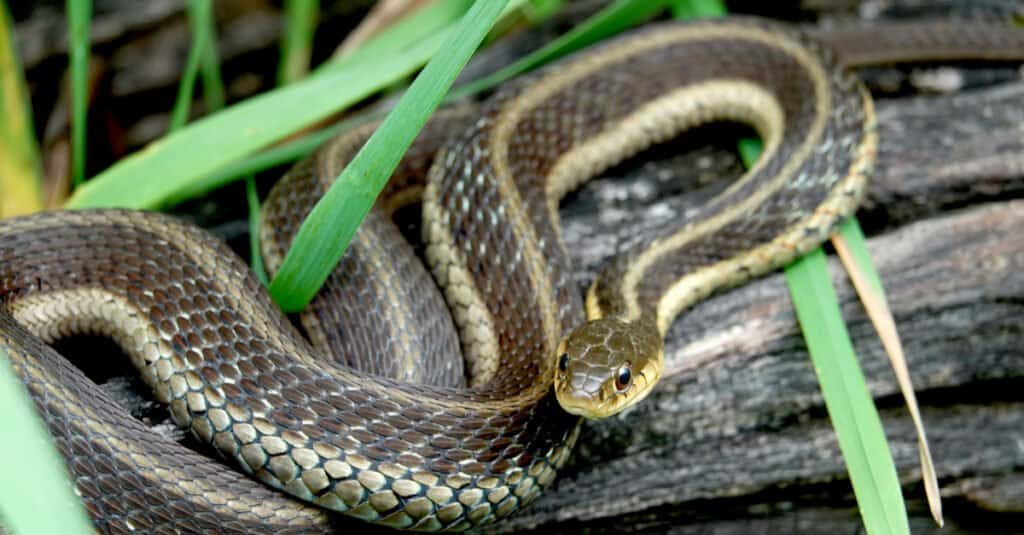
Eastern garter snakes are common snakes in Rhode Island.
©Erik Agar/Shutterstock.com
The first snake on our list is the eastern garter snake which is a subspecies of the common garter snake. These snakes are 18 to 26 inches long and are black or brown with yellow or cream stripes. Eastern garter snakes are one of the most common snakes in Rhode Island and are generally the ones that you are most likely to encounter. They live in a wide variety of habitats – including grasslands, farmland, rocky hillsides, forests, wetland regions, and even residential areas.
Eastern garter snakes have a varied diet, but mostly eat amphibians, slugs, and worms. Although they are not dangerous to humans they are mildly venomous to their prey. They produce a venom-like substance from a gland known as the Durvenoy gland. Eastern garter snakes don’t inject venom in the true sense, but it mixes with their saliva and is chewed into their prey. Bites from these snakes cause only localized swelling or itching in most cases.
2. Eastern Rat Snake (Pantherophis alleganiensis)
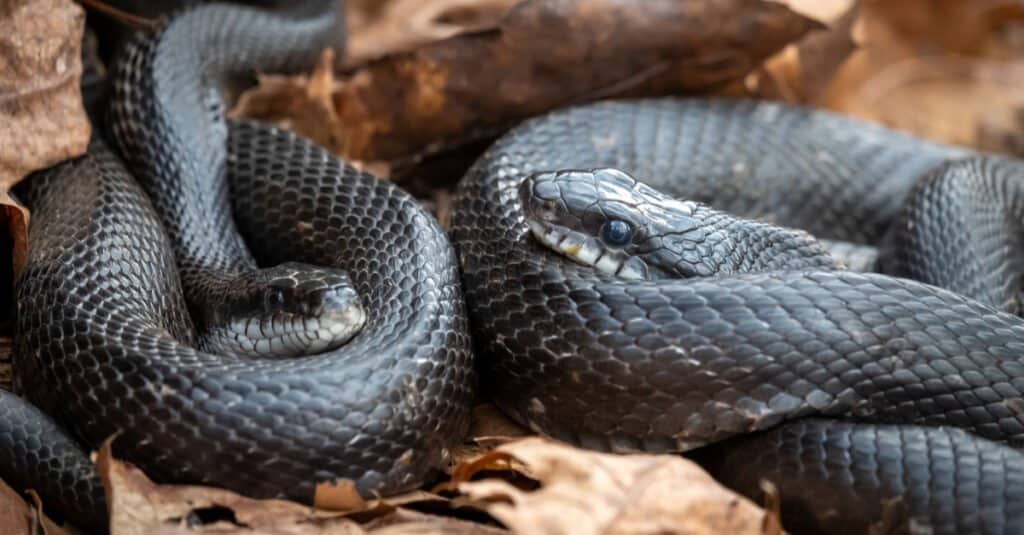
Eastern Ratsnakes brumate during the winter months.
©samray/Shutterstock.com
The next black snake in Rhode Island is the eastern rat snake which is typically 42 to 72 inches long. These snakes are black on their dorsal side with a black and white belly. They also have a cream-colored chin and throat and weakly-keeled dorsal scales.
Eastern rat snakes live in woodlands, grasslands, and river bottoms in the southwestern region of the state – mainly between Exeter and Hopkinton towns. However, they are excellent climbers and are known for their ability to climb into attics undetected. Eastern rat snakes are mainly nocturnal during the summer but are diurnal during the spring and fall. During the winter they brumate underground or in crevices.
Eastern rat snakes are powerful constrictors and prey on small mammals and birds. They are fairly slow-moving snakes and are not typically aggressive. However, they can bite when they are threatened or handled. Adults have very few predators, but juveniles are often preyed on by foxes, raccoons, and birds of prey such as hawks and owls.
3. Northern Water Snake (Nerodia sipedon)
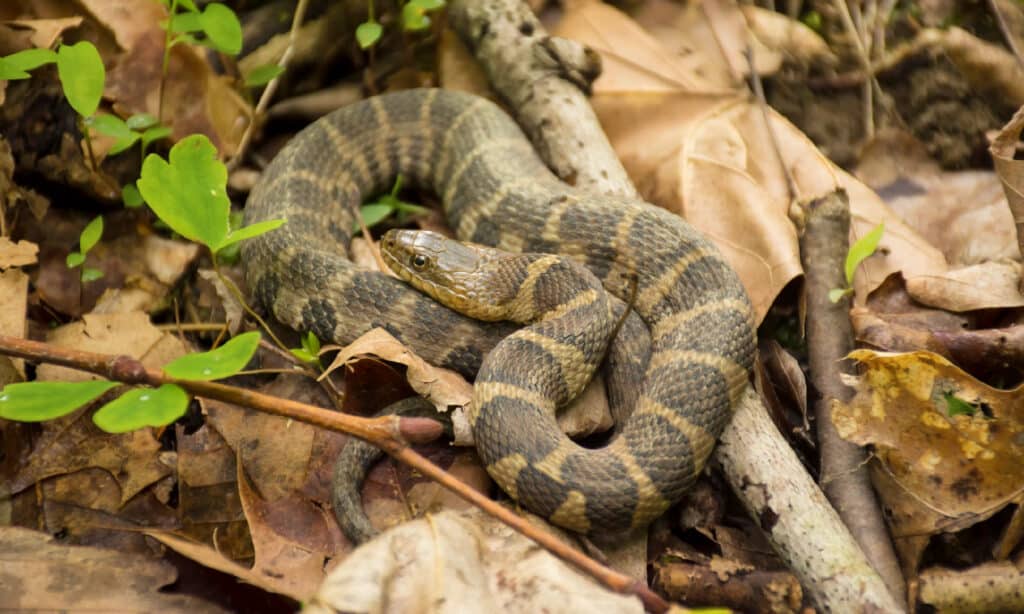
Northern water snakes are excellent swimmers.
©iStock.com/IcemanJ
The northern water snake is a large, heavy snake that is 24 to 55 inches long. It has a dark, reddish-brown body with darker crossband markings and blotches. It also has keeled dorsal scales. Northern water snakes are excellent swimmers and can be found in any wetland habitat in the state. They have a varied diet and catch their prey both in and out of the water – including small mammals, birds, fish, and amphibians.
Also, northern water snakes are not venomous, in other states where they share the same range they can easily be mistaken for venomous cottonmouth snakes. Northern water snakes do readily bite when threatened though. Their saliva contains a mild anti-coagulant which means that bites from them do bleed a lot.
4. Northern Black Racer (Coluber constrictor constrictor)
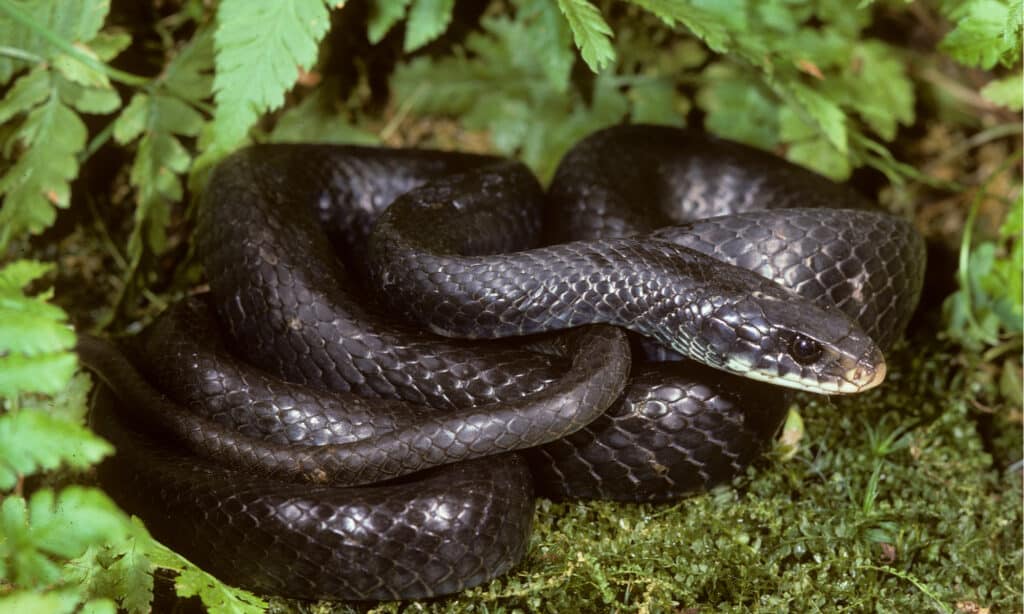
Northern black racers live in forests and grasslands in Rhode Island.
©Breck P. Kent/Shutterstock.com
Another black snake in Rhode Island is the northern black racer which is a subspecies of the eastern racer. Northern black racers are large snakes and are typically 36 to 60 inches long, although they can be longer. They are black with a white chin and a greyish-blue belly.
Northern black racers mainly live in forests and grasslands where they prey on small mammals, birds, and amphibians. They are quick, active snakes with excellent eyesight. Northern black racers can often be seen paused with their head raised above the ground as they scan the surrounding area for prey. They are quick to flee if they sense danger but can react aggressively if handled.
5. Eastern Ribbon Snake (Thamnophis sauritis sauritis)

Eastern ribbon snakes are semi-aquatic.
©Steve Bower/Shutterstock.com
The eastern ribbon snake is a subspecies of the ribbon snake and has a particularly slender body. Eastern ribbon snakes are usually 18 to 26 inches long, although longer specimens are not unheard of. They are mainly black with three yellow stripes – one along their back and one on either side. They also have a greenish-white belly. Eastern ribbon snakes are semi-aquatic and are found both in and out of the water in wetland habitats – such as swamps, streams, and ponds.
Eastern ribbon snakes are most active in the spring which is when they mate, before giving birth in the summer or early fall. They prey mainly on small fish and amphibians, but females have been known to eat their young. Eastern ribbon snakes are not dangerous but they do produce a foul musk smell if they are handled.
6. Northern Ring-Necked Snake (Diadophis punctatus edwardsii)
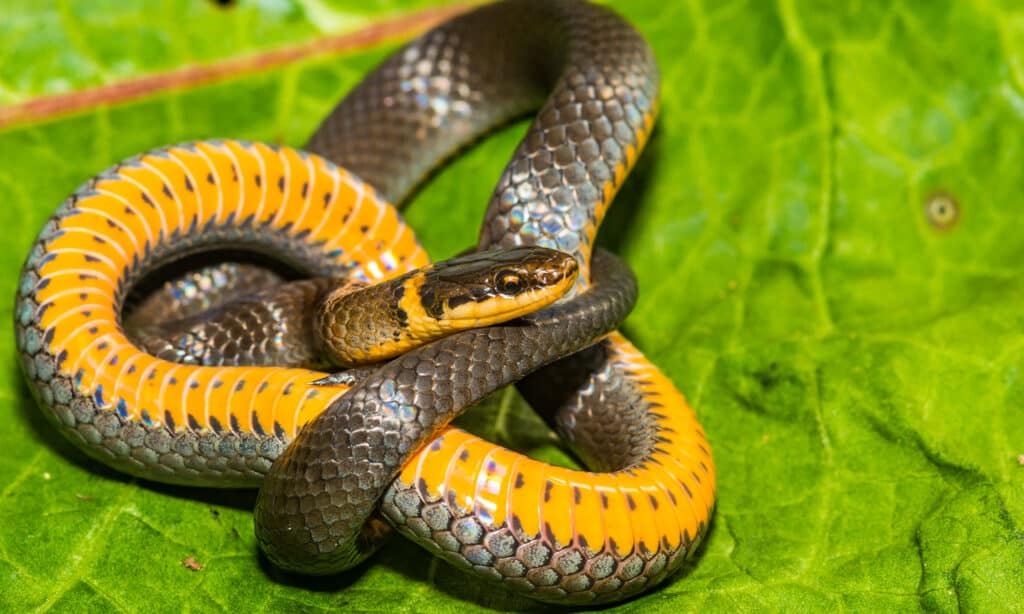
Northern ring-necked snakes are shy and secretive.
©Jay Ondreicka/Shutterstock.com
The final black snake in Rhode Island is the northern ring-necked snake which is a subspecies of the ring-necked snake. These snakes are small snakes – typically reaching only 10 to 15 inches long – and are named for the brightly colored ring around their neck.
Northern ring-necked snakes are black with a yellow or orange neck ring and a matching belly color. They live in moist woodlands where there is plenty of cover for them. They are shy and secretive snakes as well as being mainly nocturnal. This means that they are one of the least likely snakes that you will encounter in the state.
These small snakes prey only on small animals – such as earthworms, frogs, and salamanders. Like some of the other snakes in Rhode Island, they are not classed as being truly venomous and are not dangerous to humans, but they are venomous to their prey, again using the substance secreted in their Durvenoy gland.
Other Reptiles Found in Rhode Island
In Massachusetts, there are a total of 24 reptile species that reside and reproduce there, consisting of 10 turtles and 14 snakes. Additionally, every year, five species of sea turtles visit the state’s coast.
Among reptiles, coyotes, raccoons, and skunks are frequently sighted mammals and can often be found in close proximity to residential areas in Rhode Island because of their opportunistic tendencies. Rhode Island is also home to other animals, including deer, opossums, turtles, squirrels, rabbits, and various species of birds.
Here is a list of other reptiles you can find in Rhode Island:
- DeKay’s brownsnake
- Common watersnake
- Common snapping turtle
- Eastern hognose snake
- Painted turtle
- Eastern garter snake
- Eastern box turtle
- Milk snake
- Eastern racer
- Ring-necked snake
- Smooth green snake
- Common garter snake
- Thamnophis saurita
- Eastern rat snake
- Eastern worm snake
- Northern ringneck snake
- Spotted turtle
- Common musk turtle
- Wood turtle
- Eastern milk snake
- Redbelly snake
- Northern redbelly snake
Other Dangerous Animals Found In Rhode Island
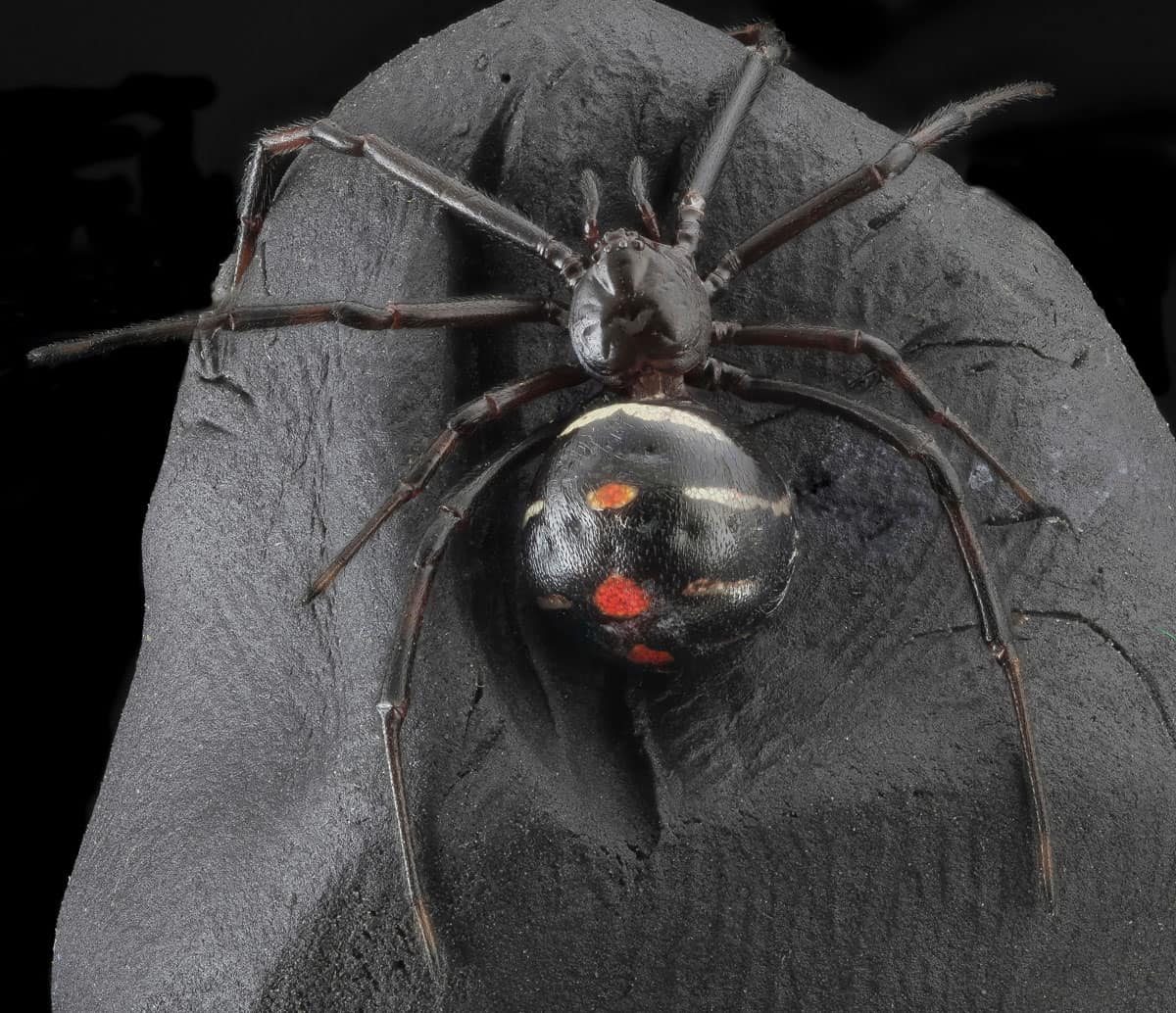
Several people are hospitalized each year due to bites from black widow spiders
©Porco_Rosso/Shutterstock.com
Black widow spiders are not only the most venomous in Rhode Island but one of the most venomous spiders in the United States. Easily one of the most recognizable spiders, with its red hourglass shape on its abdomen and a row of tiny red spots on top, this little arachnid, like all spiders, is considered a predator. Their highly toxic venom is 15 times more potent than a rattlesnake but they are not aggressive and the only time the black widow will bite is when it feels threatened and is acting in defense. These spiders prefer dry locations and like to make their homes in basements, garages, closets, and under benches. If you are bitten by this toxic insect, you may experience redness, pain, swelling, cramping, nausea, tremors, and sweating and should seek medical treatment immediately.

The black-footed
yellow sac spider
is rare but venomous.
©iStock.com/ViniSouza128
One of the more rare spiders is the black-footed yellow sac spider, also known as the American yellow sac spider. While their bites are not as severe as the black widow, they can lead to necrosis if left untreated. This spider is not very commonly seen as it is a nocturnal arachnid, although you do stand more of a chance of encounter in foliage or in a home. This spider bite is compared to a mosquito bite – it starts small and begins to increase in pain and swelling and the skin around the bite will decay, turning into a large lesion. If bitten, medical attention should be sought immediately.
Summary Of The 6 Black Snakes Found In Rhode Island
| Snakes | Scientific Name | |
|---|---|---|
| 1 | Eastern Garter Snake | Thamnophis sirtalis sirtalis |
| 2 | Eastern Rat Snake | Pantherophis alleganiensis |
| 3 | Northern Water Snake | Nerodia sipedon |
| 4 | Northern Black Racer | Coluber constrictor constrictor |
| 5 | Eastern Ribbon Snake | Thamnophis sauritis sauritis |
| 6 | Northern Ring-Necked Snake | Diadophis punctatus edwardsii |
The photo featured at the top of this post is © Andrew F. Kazmierski/Shutterstock.com
Discover the "Monster" Snake 5X Bigger than an Anaconda
Every day A-Z Animals sends out some of the most incredible facts in the world from our free newsletter. Want to discover the 10 most beautiful snakes in the world, a "snake island" where you're never more than 3 feet from danger, or a "monster" snake 5X larger than an anaconda? Then sign up right now and you'll start receiving our daily newsletter absolutely free.
Thank you for reading! Have some feedback for us? Contact the AZ Animals editorial team.






